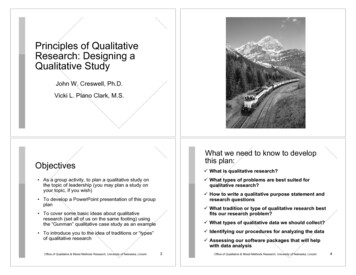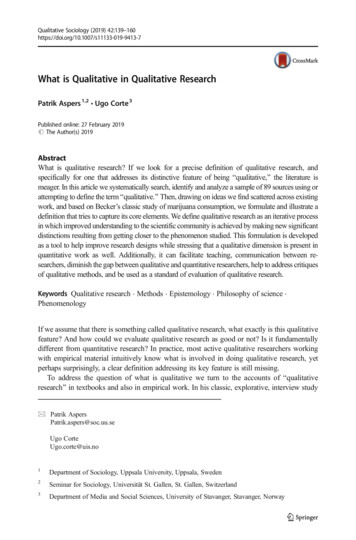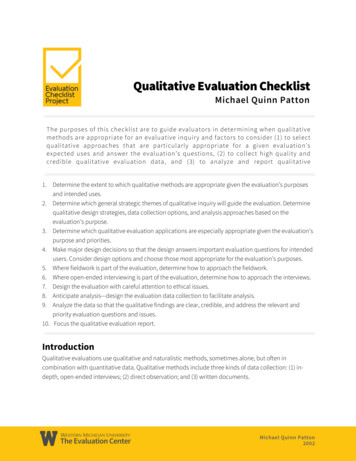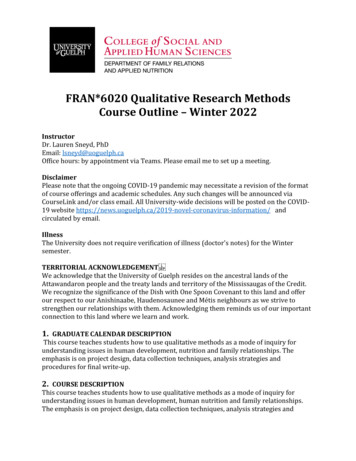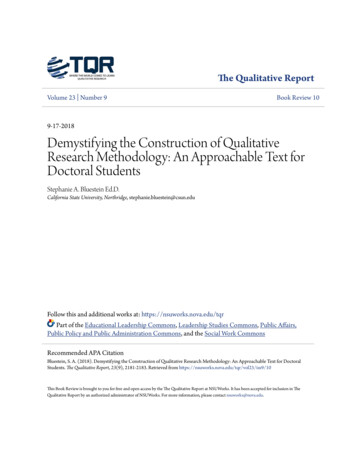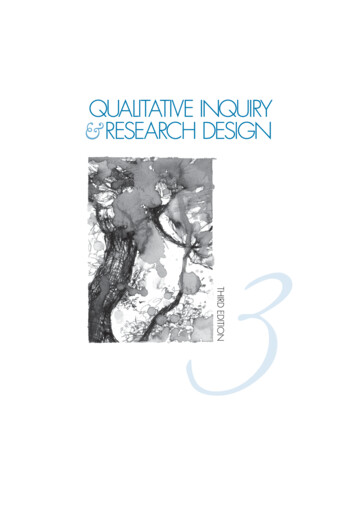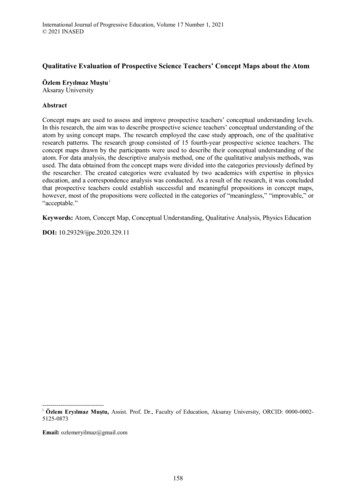
Transcription
International Journal of Progressive Education, Volume 17 Number 1, 2021 2021 INASEDQualitative Evaluation of Prospective Science Teachers’ Concept Maps about the AtomÖzlem Eryılmaz Muştu iAksaray UniversityAbstractConcept maps are used to assess and improve prospective teachers’ conceptual understanding levels.In this research, the aim was to describe prospective science teachers’ conceptual understanding of theatom by using concept maps. The research employed the case study approach, one of the qualitativeresearch patterns. The research group consisted of 15 fourth-year prospective science teachers. Theconcept maps drawn by the participants were used to describe their conceptual understanding of theatom. For data analysis, the descriptive analysis method, one of the qualitative analysis methods, wasused. The data obtained from the concept maps were divided into the categories previously defined bythe researcher. The created categories were evaluated by two academics with expertise in physicseducation, and a correspondence analysis was conducted. As a result of the research, it was concludedthat prospective teachers could establish successful and meaningful propositions in concept maps,however, most of the propositions were collected in the categories of “meaningless,” “improvable,” or“acceptable.”Keywords: Atom, Concept Map, Conceptual Understanding, Qualitative Analysis, Physics EducationDOI: -----iÖzlem Eryılmaz Muştu, Assist. Prof. Dr., Faculty of Education, Aksaray University, ORCID: 0000-00025125-0873Email: ozlemeryilmaz@gmail.com158
International Journal of Progressive Education, Volume 17 Number 1, 2021 2021 INASEDINTRODUCTIONScience education aims to bring up scientifically literate individuals. Determination andevaluation of students’ cognitive structures constitute a significant characteristic of science literacy(Bybee, 1996). It is important to reveal students’ knowledge levels to achieve meaningful learning inscience education (Robertson, 1994). The development of meaningful learning is realized via therestructuring of the present conceptual frameworks (Regis, Albertazzi, & Roletto, 1996). Formeaningful learning, students should associate newly-learned concepts with previously-learned onesand be given the chance to build their own understanding of the topic (Enger, 1998). Research showsthat there are rich, important associations among scientific concepts (Novak J. D., 1998; Novak &Gowin, 1984; Novak, Gowin, & Johansen, 1983; Novak & Ridley, 1988). Concept maps, which weredeveloped as a research instrument in the 1970s, are used by thousands of teachers worldwide, whoadapt them to various subjects to facilitate students’ understanding of the concepts. In this technique,students are requested to link the concepts in a field and to explain the relationships between them.Concept maps are among the cognitive maps designed to determine students’ knowledge of a subject.Through the synthesis of concepts, they reflect students’ knowledge and conceptual understanding of asubject. For this reason, structures such as concept maps, which schematize knowledge, are useful forscience education (Wandersee, 1994).Concept maps are the teaching materials that can be developed for various purposes, such asevaluating the knowledge of an individual or a group about a subject, developing new ideas, revealingcomplicated ideas, sharing information, or explaining the purposes of a certain subject (Cornwell,1996; Siau & Tan, 2008). Concept maps enable meaningful learning as they require students toanalyze their own knowledge and organize the concepts and relationships among them in a structuredway. Besides being used in the learning and teaching process, concept maps can also be used toevaluate students’ knowledge levels (Bauman, 2018).Moreover, the accuracy of students’ knowledge and the complexity of the knowledgestructures formed in their minds can be found out by examining their concept maps. Scientificconcepts and propositions, the relationships among them, and the degree of conceptual unity can berevealed through concept maps (Wandersee, 1994). Additionally, students’ misconceptions and therelationships they establish between irrelevant concepts can easily be revealed by concept maps. Inthis regard, concept maps are used as an instrument in achieving meaningful learning, evaluating andplanning the teaching process, finding alternative concepts, or exploring students’ misconceptions(Cheema & Mirza, 2013; Enger, 1998; Nesbit & Adesope, 2006; Novak & Cañas, 2006; Novak J. D.,1980).The most significant characteristic distinguishing concept maps from many other graphicorganizers is their use for both increasing meaningful learning as an educational strategy andevaluating the conceptual understanding as an assessment instrument. It is the optimum evaluationinstrument in which students freely express exactly what they know, without referring to any source.Following an average of 4-5 hours of training on how to create concept maps, students’ conceptualunderstanding of a subject can be assessed very easily. Before teachers use the concept maps as anevaluation instrument, they should create concept maps together with students for at least 3-4 weeks,depending on the students' levels. Doing so will increase the reliability and validity of concept maps asan assessment and evaluation instrument (Kaya, 2003).Considering the studies using concept maps as an evaluation instrument (McClure, Sonak, &Suen, 1999; McClure & Bell, 1990; Novak & Gowin, 1984; Ünlü, İlgeç, & Taşar, 2006), thedifference in the scoring method draws attention due to the criteria related to the determination of theevaluation topics because concept maps can be used for both quantitative and qualitative evaluation(Williams, 1998). Kinchin, Hay, & Adams (2000), who used concept maps as a qualitative evaluationinstrument, stated that concept maps as an instrument could be used to determine students’ knowledgelevels as well as to guide future learning processes.159
International Journal of Progressive Education, Volume 17 Number 1, 2021 2021 INASEDAs with the evaluation process, the ways to create and use concept maps are quite diverse(Williams, 1998). Some researchers such as Novak & Gowin (1984), who pioneered concept mapping,think that a concept map should have a hierarchical structure, whereas other researchers such asHarnisch, Sato, Zheng, Yamagi, & Connell (1994) believe that it should have a structure like a spiderweb in which there is a concept in the center and relationships are established with the surroundingconcepts. In the development of concept maps, the technique “fill in the blanks in the drawn map,”which is a highly guiding technique, or the technique “draw a map from scratch,” which is a lessguiding technique, can be used. In their study, Ruiz‐Primo, Schultz, Li, & Shavelson (2001) discussedthese two different techniques and concluded that the technique “draw a map from scratch” reflectedthe difference between students’ knowledge structures more effectively. Besides, concept maps, whichcan be prepared by students individually, can help students acquire a strong grasp of the subject beingtaught as well as develop high-order thinking skills such as problem-solving skills (Eden, 1988).PurposeThe mapping process is “a self-learning experience” as the creation of a concept map requiresstudents to define the relationships between concepts (Jacobs-Lawson & Hershey, 2002). Conceptmaps present an image of how the basic concepts in a field are organized and structured in a person’smind. The image of the scientific concepts in a prospective science teacher’s mind is of greatimportance for the correct teaching of the subjects to students. It is, therefore, important for eachprospective science teacher to learn the scientific concepts properly and to express the relationshipsbetween the concepts accurately. In the study, the concept maps were developed based on the “draw amap from scratch” technique. The atom, which is one of the basic concepts of both physics andchemistry, was selected as the subject of concept maps since it is not only an interdisciplinary conceptbut also frequently used in daily life. Hence, it is important to reveal how prospective teachersorganize the concept of the atom in their minds. The study was carried out to qualitatively evaluate theconcept maps developed by prospective science teachers about the atom. Furthermore, it was aimed toidentify the structural mistakes that were made while developing the concept maps.METHODIn this qualitative research, which was conducted to determine prospective teachers’conceptual understanding of the atom by means of concept maps, the integrated single-case patternfrom case study methods was used. A case study seeks to investigate the detailed results through thein-depth examination of a case. A case study is also a way of seeing what is actually happening in theenvironment, systematically collecting and analyzing data, and presenting the results. The output ofcase studies is the proper demonstration of why the case happened in the way it happened and whatfuture research should focus on (Aytaçlı, 2012; Davey, 1991). In this research, this pattern wasemployed to describe prospective science teachers’ conceptual understanding of the atom.Study GroupThe research was conducted with the participation of 15 fourth-year prospective scienceteachers attending a state university. To create the study group, the criterion sampling method, whichis one of the purposive sampling methods, was used. The purposive sampling enables the selection ofappropriate cases depending on the purpose of the study and the execution of in-depth research(Büyüköztürk, Çakmak, Akgün, Karadeniz, & Demirel, 2016). Criterion sampling is the creation ofthe sampling units by the researcher in line with a series of pre-defined criteria (Baş & Akturan, 2017).While determining the study group, the following criterion was established: having taken all thephysics and chemistry courses covering the subjects related to the atom. Prior to the research, theparticipants were informed about the subject and the process of the study. Moreover, the participatingprospective teachers were asked to consent to the use of their concept maps as research documents.160
International Journal of Progressive Education, Volume 17 Number 1, 2021 2021 INASEDData Collection Tool and ImplementationAs the data collection tool, the concept maps developed by the participating prospectiveteachers were used. Firstly, prospective teachers were informed about concept maps. Afterward, asample concept map was developed together with the participants. Then, the participants were dividedinto groups, and each group was requested to develop a concept map about physics. Once it wasdetermined that they were able to develop concept maps, they were asked to create their own conceptmaps about the atom. Finally, the concept maps were separately examined to obtain data for theresearch.Data AnalysisWhen the data collected by means of concept maps are subjected to quantitative analysisalone, numerical findings such as the number of concepts or of connections come to the fore. Doingso, in turn, minimizes the importance of the content of concept maps. To eliminate this problem, thepresent study employed the descriptive analysis method, one of the qualitative data analysis methods,to analyze the data obtained from concept maps. Descriptive analysis is the summarization andinterpretation of the data obtained in a study according to the predefined themes (Yıldırım & Şimşek,2016). Each concept map was separately examined. First of all, all the propositions in the conceptmaps were scientifically evaluated under four main categories: “successful,” “acceptable,”“improvable,” and “meaningless.” Two criteria were taken into consideration while the categorieswere created. The first criterion was whether the proposition was scientifically correct. When trying tointerpret a proposition in a concept map, one needs to read first the concept at end of the arrow, thenthe concept at the tip of the arrow, and consequently the relationship between the two. The secondcriterion in the evaluation process was whether the proposition was structurally in compliance with therule of establishing a proposition. The main categories used in the research are as follows:Successful: The proposition is scientifically correct and complies with the rule of establishinga proposition in the concept map.Acceptable: The proposition contains incomplete scientific knowledge and complies with therule of establishing a proposition in the concept map.Improvable: The proposition is scientifically incomplete/incorrect due to the incorrectlydirected arrow.arrow.Meaningless: The proposition is scientifically incorrect regardless of the direction of theFirst, all of the propositions established by the participants were categorized regardless of theirfrequencies. Then, percentage and frequency analyses were performed for each category. Then, thepropositions in each category were divided into three sub-categories (the atom,” “the structure of theatom” and “atomic models”), and the frequency of the categorized propositions was determined. Inthis way, it was tried to determine the participants' incomplete knowledge about both the atom and thecreation of concept maps.After the propositions were categorized, the propositions in each category were reviewed indetail. In each category, the propositions related to the atom, the propositions related to the particlesthat comprise the structure of the atom, and the propositions related to the atomic models wereexamined by considering their frequency values. Besides, the hierarchies of the concept maps weretaken into consideration while the propositions in the “acceptable” category were examined. Thehierarchical connections of the propositions, which were meaningless alone but gained meaning withhierarchy, were included.161
International Journal of Progressive Education, Volume 17 Number 1, 2021 2021 INASEDRESULTSThis section is devoted to the assessment of the findings obtained from the concept maps.First, the propositions were categorized without taking their frequency into account, and the number ofpropositions was determined. Percentage and frequency analyses were performed for each category.Percentage and frequency values of the propositions according to categories are given in Table 1.Table 1. Percentage and frequency values of the propositions according to aninglessTotalf2515154297%2615.515.543100Sample proposition*The nucleus is in the atom.*Grape cake is a model.*The atom developed the Thomson model.*Bohr proposed the modern atomic model.When Table 1 is examined, it is seen that 97 different propositions were established by theparticipants. While categorizing the propositions, the propositions expressing scientifically correctinformation (e.g., “The nucleus is in the atom”) were gathered in the category of “successful”propositions. It was observed that 26% of the propositions were in the “successful” category. If thepropositions contained incomplete scientific knowledge, they were included in the category of“acceptable” propositions. For example, the proposition “Grape cake is a model” was included in thiscategory. Not the grape cake but the plum pudding is an analogy for Thomson’s atomic model (Han &Goldstein, 2013; Hentschel, 2009; Harrison & Treagust, 1996). However, in some coursebooks, thisanalogy is stated as the grape cake model (Karagöz & Sağlam Arslan, 2012). Hence, such propositionswere not considered incorrect because the hierarchy was considered acceptable. As a result, 15.5% ofthe propositions were evaluated in the “acceptable” category. During the examination of the conceptmaps, some incorrectly linked terms (misdirected arrows) and, as a result, incorrect or meaninglessexpressions also emerged. It was thought that if the participants had learned how to use the conceptmapping technique properly, a meaningful and successful proposition would have been established.Therefore, such propositions were evaluated in the “improvable” category. The propositions in the“improvable” category were those that contained scientifically correct information but failed to linkthe terms correctly. For example, the proposition “The atom developed the Thomson model” ismeaningless, however, if the direction had been correctly indicated by the arrow, the proposition“Thomson developed an atomic model” would have been established successfully. 15.5% of thepropositions were collected in the “improvable” category. On the other hand, 43% of the propositionswere scientifically incorrect (e.g., “Bohr proposed the modern atomic model”). These propositionswere collected in the “meaningless” category.Examination of the successful propositionsThis section is devoted to the examination of the successful propositions established by theparticipants. Firstly, the propositions were divided into three sub-categories: “the atom,” “the structureof the atom” and “atomic models.” Then, the frequency of the categorized propositions wasdetermined. The successful propositions are shown in Table 2.Table 2. Successful propositions and their frequency valuesThe AtomCategoryPropositionAn atom contains protons.An atom contains neutrons.An atom contains electrons.There are atomic models.An atom consists of subatomic particles.The modern atomic model contains an energy level.162f9910511
TotalAtomic modelsThe Structure of theAtomInternational Journal of Progressive Education, Volume 17 Number 1, 2021 2021 INASEDThe nucleus is in the atom.The nucleus is the center of the atom.The spin is in the electron.The electron is in the orbital.Three quarks form a neutron.Three quarks form a proton.Quark is one of the subatomic particles.The modern atomic model is one of the atomic models.Bohr proposed an atomic model.Rutherford proposed an atomic model.Dalton proposed an atomic model.Dalton’s atomic model is similar to the solid sphere.Thomson proposed an atomic model.Thomson’s atomic model is similar to a grape cake.The modern atomic theory contains the term “spin.”The modern atomic theory contains the term “quark.”Heisenberg articulated the uncertainty principle for the first time.Pauli articulated the exclusion principle for the first time.Schrödinger developed the wave equation.256212111145696131111109125When Table 2 is examined, it is seen that 25 propositions are collected in the category of“successful” propositions. A majority of the propositions that fell under the sub-category of “theatom” were related to the parts of the atom: electrons, protons, and neutrons. Six participants said intheir propositions that the nucleus was in the structure of the atom, and two mentioned the position ofthe nucleus in the atom. Besides, it was discovered that the participants established propositionsrelated to the historical development of the atomic models. When the propositions about the historicaldevelopment of the atomic models are reviewed, it is seen that 13 participants expressed an analogyfor Thomson’s atomic model, and nine mentioned an analogy for Dalton’s atomic model. It wasdetermined that only one of the successful propositions was related to the modern atomic model. Also,when Table 2 is examined, it is seen that the participants established propositions about Heisenberg’suncertainty principle, Pauli’s exclusion principle, and Schrödinger’s wave equation, but they did notinclude any information about these principles in their propositions. Finally, only one participant saidthat quarks make up protons and neutrons.Examination of the acceptable propositionsThis section is devoted to the examination of the acceptable propositions. When examining thepropositions in this category, the hierarchies of the concept maps were taken into consideration. Thepropositions, which were meaningless on their own but gained meaning through hierarchies, were alsoevaluated in this category. As with the successful propositions, the acceptable propositions were alsodivided into three sub-categories: “the atom,” “the structure of the atom” and “atomic models.” Thefrequency and hierarchies of the categorized propositions were determined. Acceptable propositionsand their frequency values are given in Table 3.Table 3. Acceptable propositions and their frequency valuesThe Structure ofThe Atomthe AtomCategoryPropositionAn atom is a filled sphere.An atom consists of protons.An atom consists of neutrons.An atom consists of electrons.An atom is divided into orbitals.An atom consists of a nucleus.The nucleus consists of protons.The nucleus consists of neutrons.The nucleus is a subatomic particle.The orbital is the energy level.The electron circulates in the orbital.f12221111125163Position in the concept mapDalton proposed an atomic model.Bohr proposed an atomic model.An atom consists of a nucleus.An atom consists of a nucleus.An atom consists of subatomic particles.The electron circulates in the orbital.The orbital is the energy level.
Atomic modelsInternational Journal of Progressive Education, Volume 17 Number 1, 2021 2021 INASEDTotalThe grape cake is an atomic model.The orbital performs a spin motion.Pauli dealt with the atom.111Heisenberg dealt with the atom.21524The spin is in the electron.Pauli articulated the exclusion principle for thefirst time.Heisenberg articulated the uncertainty principlefor the first time.When Table 3 is examined, it is seen that 15 of the propositions are collected in the categoryof “acceptable” propositions. For example, a participant established the proposition “An atom is afilled sphere.” Atom is not a filled sphere; however, Dalton described the atom as a filled sphere whenthe history of the atomic models is reviewed. In the same hierarchy, the participant correctly proposedthat “Dalton proposed an atomic model.” As it complements the aforementioned proposition, theproposition “An atom is a filled sphere” was evaluated in the “acceptable” category.Figure 1. A sample concept map by Student 1Figure 2. A sample concept map by Student 14The propositions “An atom consists of protons,” “An atom consists of neutrons,” and “Anatom consists of electrons” stated in Table 3 are not scientifically correct or successful. However,when the related concept map is examined in Figure 1, it is seen that the participant did not think theatom consisted of only protons, only neutrons, or only electrons. On the contrary, the participant triedto express that an atom includes all those in its structure. For this reason, these propositions wereevaluated in the “acceptable” category. Similarly, the proposition “An atom consists of a nucleus” isnot scientifically correct. Also, when the concept map in Figure 2 is examined, it is seen that theparticipant used “the nucleus” in the following hierarchy, in the propositions “The nucleus consists ofprotons” and “The nucleus consists of neutrons”. This indicates that the participant did not think thenucleus consisted of only neutrons or only protons; it was just that the participant could not expressthe relationship correctly. Therefore, this proposition was evaluated in the category of “acceptable”propositions.164
International Journal of Progressive Education, Volume 17 Number 1, 2021 2021 INASEDFigure 3. A sample concept map by Student 8When Table 3 is examined, the acceptable propositions “An atom is divided into orbitals,”“The orbital is the energy level,” and “The electron circulates in the orbital” are seen. When Figure 3is examined, it is seen that the propositions related to “Bohr’s atomic model” constitute the basis ofthese propositions. These propositions about Bohr’s atomic model were evaluated in the category of“acceptable” propositions. The propositions “Pauli dealt with the atom” and “Heisenberg dealt withthe atom” were also evaluated in the category of “acceptable” propositions. When the concept mapswere examined, it was discovered that the participants included in the hierarchy the propositionsrelated to Pauli’s exclusion principle and Heisenberg’s uncertainty principle. This shows that theparticipants tried to express Pauli and Heisenberg’s studies on the atom.As regards the proposition “The grape cake is an atomic model,” the grape cake is not anatomic model. The grape cake is an analogy for Thomson’s atomic model. However, the propositiongains meaning when it is evaluated together with the proposition related to Thomson’s atomic model.For this reason, the proposition was examined in the “acceptable” category. The proposition “Theorbital performs a spin motion” was also included in the “acceptable” category. This proposition wassupported by the proposition “The spin is in the electron.” It is obvious that the participant tried toestablish a proposition related to the motion of the orbital by making use of the spin motion of theelectron. This proposition, which was meaningless on its own, was evaluated as an acceptableproposition when examined together with the hierarchical structure.Examination of the improvable propositionsThis section is devoted to the examination of the improvable propositions. While thepropositions in this category were being reviewed, care was taken to determine whether theproposition structurally complied with the rules of concept maps. As stated above, to interpret thepropositions meaningfully in a concept map, one needs to read first the concept at end of the arrow,then the concept at the tip of the arrow, and consequently the relationship between the two. Thepropositions written by the participants by not complying with this rule were evaluated in the“improvable” category. These propositions were also divided into three sub-categories: “the atom,”“the structure of the atom,” and “atomic models.” The frequency of the categorized propositions andthe propositions that would otherwise be correctly written if the direction had been correctly indicatedby the arrow were determined. Improvable propositions and their frequency values are given in Table4.165
International Journal of Progressive Education, Volume 17 Number 1, 2021 2021 INASEDTable 4. Improvable propositions and their frequency valuesAtomic modelsThe Atom andThe Structure of theAtomCategoryTotalPropositionfThe atom is in the orbital.The atom is in the structure of the nucleus.The atom is related to the orbital.The nucleus is in the proton.The nucleus is in the neutron.Energy levels are in the electron.The orbital is in the electron.The atom is in the energy levels.The atom developed the Bohr model.The atom developed the Rutherford model.The atom developed the Dalton model.The atom developed the Thomson model.The atom conducted studies on Schrödinger.The atom conducted studies on Pauli.The atom conducted studies on Heisenberg.1523111112655776654The proposition that would have emerged if thedirection had been correctly indicated by the arrowThe orbital is in the atom.The nucleus is in the structure of the atom.The orbital is a concept related to the atom.The proton is in the nucleus.The neutron is in the nucleus.The electron is in the energy levels.The electron is in the orbital.The energy levels are in the atom.Bohr developed an atomic model.Rutherford developed an atomic model.Dalton developed an atomic model.Thomson developed an atomic model.Schrödinger conducted studies on the atom.Pauli conducted studies on the atom.Heisenberg conducted studies on the atom.When Table 4 is examined, it is seen that 15 of the propositions are collected in the categoryof “improvable” propositions. For example, “The atom developed the Thomson model” is an“improvable” proposition. By reversing the direction of the arrow, the proposition can be mademeaningful: “Thomson developed an atomic model.” It was found out that the propositions that fellunder this category were mostly related to scientists investigating the atomic models. Five participantstried to establish propositions related to Dalton and Rutherford’s atomic models, six tried to establishpropositions related to Bohr’s atomic model, and seven tried to establish propositions related toThomson’s atomic model. When the propositions about the atomic models were reviewed, it wasdetermined that they only contained information about the scientists who proposed these models.Besides, there were propositions related to the nucleus, protons, neutrons, and electrons, whichconstitute the atom and the structure of the atom. For instance, “The nucleus is in the proton” is an“improvable” proposition. When the direction of the arrow is reversed, this proposition can be mademeaningful: “The proton is in the nucleus.” It is, therefore, possible to say that the corrected versionsof the propositions related to the particles that comprise the atom and the structure of the atom aregenerally acceptable propositions.In Table 4, it is observed that the participants established propositions about the studies layingthe foundation of the modern atomic model. However, they were unable to go beyond associating thenames of the scientists with their theories in these propositions. When the corrected version of thepropositions in this category was examined, it was discovered that not all the propositions were correctand some propositions were in the “acceptable” category. Moreover, Table 4 shows that theparticipants failed to establish new proportions: those in the “successful” and “acceptable” categorieswere reiterated.Examination of the meaningless proportionsThis section is devoted to the examination of meaningless propositions. Regardless of whetherthe arrow indicated the correct direction, scientifically incorrect propositions were gathered in thiscategory. The frequency of the categorized propositions was determined. The meaninglesspropositions and their frequency values are given i
In this research, the aim was to describe prospective science teachers' conceptual understanding of the atom by using concept maps. The research employed the case study approach, one of the qualitative research patterns. The research group consisted of 15 fourth-year prospective science teachers. The
